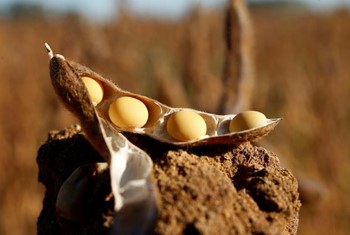In 2019, the price of cooking oil ranked first among commodity products in the agricultural group whose price increased due to the decline in oil seeds by African pig cholera. Price of arabica coffee, soybean oil, sugar, wheat ... also tended to increase ...


Vegetable oil prices rise
Palm oil prices in Malaysia fell again in the last day of 2019, due to profit-taking activities, but the year had the strongest increase in a decade, due to the expected reduction in production and consumption in leading producing countries. Indonesia and Malaysia increased.
The price of palm oil in March 2020 on Bursa Malaysia ended 2019 at 3,046 ringgit (744.93 USD) / ton; For the whole year of 2019, the price of palm oil increased by 44%, with the average price in 2019 reaching 2,560 ringgit / ton - the highest since 2009.
According to official data released on December 10 by the Government of Malaysia, the country's palm oil reserves fell 4.1% to 2.3 million tons in November 2019, the lowest level in the past three months. , amidst weak production context putting pressure on export activities.
The Palm Oil Association of Malaysia and the Palm Peninsula Oil Mill Association of the South of the country respectively forecast palm oil production in December 2019 to decrease by 16% and 27% compared to November 2019, down more sharply than expected. ant. Meanwhile, domestic consumption of palm oil in Malaysia and Indonesia is expected to increase as both countries require palm oil components in the 2020 biofuel program.
Palm oil exports of Malaysia in December 2019 decreased by 4.9% -6.7%, commodity surveyors Intertek Testing Services and Amspec Malaysia said. Although Malaysia's palm oil exports to major markets have declined over the past few years, the country's palm oil exports to China in November increased by 23.5% over the previous month, reaching 340,230 tons. , mainly due to increased buying activity ahead of the Lunar New Year, while trade relations between Malaysia and China have improved. Malaysia signed a memorandum of understanding with the Chinese Chamber of Commerce to import palm food, natural products and pet products in order to increase palm oil exports by 1.9 million tons to China in 2019-2023. . The world's second largest producer of palm oil also "shook hands" with the Bohai Commodity Exchange (China) about pledging to supply China with about 1.5 million tons of palm oil by 2020.
Analysts remain optimistic about the prospects for palm oil prices in 2020 as palm oil production of the world's two largest producers, Malaysia and Indonesia, may be constrained by drought weather across Southeast Asia.
MIDF Research reports on December 11, 2019, saying that supply is tight and demand is expected to increase from key palm oil importing countries like China, which still helps to price this item. keep on increasing next year. The firm predicts crude palm oil prices will reach 2,450 and 2,600 ringgit / ton respectively in 2020 and 2021. MIDF Research predicts this trend will continue next year, with recent trade deals between two countries.
For soybean oil, China often imports soybean oil to get oil for pressing, so soybean oil is a by-product of oilseed. The slump in demand for animal feed has led to a drop in soybean oil production and pushed up soybean oil prices by almost a fifth in 2019. Palm oil - a product that competes with soybean oil - on Dalian and oil prices rapeseed on Zhengzhou also increased.
China is expected to increase soybean imports in 2020 as the pig herds gradually recover. Therefore, the supply of soybean oil will also increase, putting pressure on cooking oil prices.
Pork prices soared
Global pork prices in 2019 increased due to African swine cholera.
In the US, prices on the Chicago floor increased 7.9% in 2019, whereby the lean pig contract for February 2020 ended the year at 71,425 US cents / lb. The reason for the increase is the expectation that China will continue to increase US pork imports. US pork exports to mainland China and Hong Kong in the first 10 months of 2019 increased by 55% in volume and 34% in value over the same period last year.
In China, the price of pork in 2019 fluctuated sharply: the price of live hog remained at a low level of 12-14 CNY / kg in the first 3 months of 2019, starting from April 2019 and continuously increasing sharply, reaching the record level. in the last week of October 2019 reached 54 CNY / kg (equivalent to 177,000 VND / kg, 1.4 times higher than in September 2019 and 4.4 times higher than in early 2019) due to the Chau cholera epidemic. Africa. However, from November 2019, prices began to decline and ended 2019 at 34- 35 CNY / kg, down 36% from a record in late October 2019 but still increased sharply by 2.8 times. compared to early 2019. Cholera has killed 40% of the country's pigs.
An outbreak of African swine fever has killed 100 million pigs in China. This situation makes the price of pork in China double since the beginning of 2019. Beijing has many policies to improve the supply such as supporting farmers to re-stock, discharge frozen storage, import ... China has just announced a reduction of tax on frozen pork to make up for the shortage of supply.
According to the General Administration of China Customs, pork imports in November increased by more than 150% over the same period in 2018, to nearly 230,000 tons. This is the highest level since 2016 when the world's largest pig consumption market faced a supply crisis.
The import level in November also increased by 30% compared to nearly 180,000 tons in October. 11 months of 2019, China imported more than 1.7 million tons of pork, up 58% from the previous year. Apart from pork, China also imported nearly 78,000 tons of chicken and 1.47 million tons of beef, an increase of 71% and 57.3%, respectively, compared to 2018.
Rabobank predicts that China will regroup on a small scale and import in 2020 and large scale before pig production will increase until 2025, when the market is balanced again and prices are stable. According to the bank, even by 2025, China's total pig herds will not reach the level of 2018.
Cotton prices fell for the second year in a row
Cotton prices in 2019 decreased due to fears that the US-China trade war will reduce cotton consumption globally (because the US and China are the world's leading cotton exporters and consumers.
On New York Stock Exchange, the futures for 3-month delivery ended in 2019 at US $ 69.05 per lb, down 4.4% from the end of 2018.
Cotton prices on the Zhengzhou floor also plummeted in 2019 due to the trade war, which also reduced demand for textile products. However, by 2020 this item could benefit from a calming trade war.
Grain prices have mostly increased
Prices of wheat, maize and soybeans in the US increased for the year after the "Phase 1" US-China trade agreement, boosting exports of agricultural products and supporting price increases.
On Chicago floor, soybean futures price in March 2020 ended 2019 at 9.55-1 / 2 USD / bushel, the highest in 18 months. For the whole year, soybean price increased by 6.8%. The price of wheat delivered in the same period ended at 5.58-3 / 4 USD / bushel, lower than the 16-month peak (5.64-1 / 2 USD / bushel) in the previous session; For the whole year of 2019, wheat price increased by 11% and was the 3rd consecutive year of increasing due to the decrease in supply in the Southern Hemisphere, especially Australia - where has been in drought for 3 years. Maize futures prices in March 2020 decreased by half US cents to 3.87-3 / 4 USD / bushel. For the whole 2019, corn prices increased by 3.4%.
In 2020, the grain market is forecast to be affected by a number of factors such as: Brazilian supply, demand in China ...
Pepper prices are forecast to continue to decline
Pepper prices in Malaysia market have dropped for the 4th year in a row and may not yet bottom out. Specifically, the price of Kuching white pepper type 1 ended 2019 at 12,720 ringgit / ton, while black pepper was 6,700 ringgit / ton. Compared to the end of 2018, the price of white pepper has lost about 35%, while black pepper has lost about 28%. Malaysia's pepper production in 2019 is estimated at 17,000-18,000 tons, lower than the 20,000 tons of previous years.
Remarkably, Malaysian pepper price keeps dropping while pepper price of some countries like Vietnam, Indonesia, India ... recovered slightly in recent time. Even so, the price is still not up to the level of the end of 2018.
In India, black pepper prices ended 2019 at around 330 - 350 rupees / kg. However, in October 2019, the price fell below 300 rupees per kg, the lowest level in a decade due to the oversupply in the global market and increased imports into India. Indian pepper prices recently maintained the highest in the world, nearly double that of Vietnam, Brazil and Indonesia, and about 20% higher than Malaysian pepper. Over the past few years, the country has produced only 50,000-60,000 tons of pepper annually.
Global pepper supply in 2020 is expected to continue to be redundant by the output of about 600,000 tons while consuming only 450,000 tons. Therefore, the price is expected to be under further downward pressure.
Milk prices soared
Milk prices in the world market in 2019 increased sharply due to lower production in Northern Europe and Australia while demand in China increased.
In Oceania, the average price of skimmed milk powder in 2019 increased by 31.99% compared to 2018, to US $ 2,632 / ton; By the end of 2019, the price of this milk will be at 3,088 USD / ton. Whole milk powder on average price in 2019 was US $ 3,140 / ton, up 4.82% compared to 2018; This type ends in 2019 at US $ 3,375 / ton - the highest since August 2015. Meanwhile in Europe, the average price of whole milk powder in 2019 was 2,940 EUR / ton, up 7.3% compared to 2018; ending these five categories at 3,042 EUR / ton - the highest since April 2016.
Arabica coffee prices increased by about 30% in 2019, while rubber in Tokyo increased by nearly a fifth, while raw sugar increased by more than 10%.
Sugar prices rise
Raw sugar futures prices for March 2020 on ICE ended 2019 at 13.43 US cents / lb. For the whole year, raw sugar price increased by 11.6% - the first increase in 2 consecutive years of decline. The price of white sugar in March 2020 on London floor ended 2019 at 359.2 USD / ton and in 2019 also increased by 8%.
The US Department of Agriculture (USDA) just released its report on world trade and markets on November 21. Accordingly, global sugar production is forecast to decrease by 6 million tons from October 2019 compared to the previous crop, to 174 million tons in the 2019/2020 season. This reduction is mainly due to sugar production and sugarcane area from India. The country may see sugar production fall to 5 million tons in the 2019/2020 season, falling to 29.3 million tons as both productivity and sugarcane area decrease.
Global sugar consumption will continue to increase in 2020 mainly because of a record-breaking demand in India, which is estimated to reach a record 28.5 million tons in the new crop. World sugar exports will not increase compared to last year and the countries' sugar stockpiles are expected to decline by 5% to 50 million tons. However, according to the USDA, India's sugar exports will reach 5 million tons in 2020 as the country holds a record high inventories of sugar at 14.5 million tons.
Also according to USDA, US sugar production will decrease by 4% to 7.8 million tons in the new crop because unfavorable weather conditions make sugar beet's productivity decline. Next year, the US may import 2.9 million tons of sugar, a slight increase compared to this crop. Sugar production in Brazil is forecast to decline slightly to 29.4 million tons as most of the sugarcane output is converted to bioethanol. Meanwhile, only about 35% of sugarcane production is for sugar production. USDA stated that Brazil's sugar export will decrease by 1 million tons compared to last year, falling to 18.6 million tons, the lowest in 12 years.
Sugar production of the European Union (EU) will increase slightly to 17.9 million tons in the new crop but due to higher consumption than supply, the EU will net import of about 0.5 million tons. Thailand's sugar output is forecast to decrease by 1 million tons to 13.5 million tons. Meanwhile, China's sugar output will increase slightly to 10.9 million tons due to expanded sugarcane and sugar beet growing areas.
A recent report by Rabobank Bank (Netherlands) forecasts that the world market in the 2019/2020 crop will be 5.2 million tons short, the highest level in 4 years. Therefore, the report stated that the future price of raw sugar on ICE will increase stably to 14 US cents / lb in quarter 4/2020.
Luca Meierhofer, a leader at Louis Dreyfus Agricultural Products Group (Netherlands), predicts that the sugar market will be short of 6.7 million tons in the new crop due to the significant decline in output in the northern hemisphere. However, he said that the large inventories of sugar in India, Thailand and Brazil, as well as the slow increase in global demand for sugar, will limit the impact of this shortage on future sugar prices. Therefore, Luca predicts future sugar prices will fluctuate in the range of 11-14 US cents / lb next year. With prices not yet rising, sugar producing countries will not be eager to increase production in this situation.
Coffee prices evolved in opposite directions
Arabica coffee prices have just experienced a sharp increase year after year because investors are still concerned about tight global supply. Arabica coffee prices on the floor of New York ended 2019 at 1,297 USD / lb; For the whole year of 2019, robusta price increased by 27% after decreasing for two consecutive years 2017 and 2018. The price of robusta coffee on London ended the end of 2019 at $ 1,382 / ton, however, for the whole year. decreased by 9.4% - the 3rd consecutive year of reduction.
Brazil, the largest supplier of instant coffee in the world, is boosting exports to Southeast Asia, especially towards rival countries including Vietnam. According to Bloomberg, in November, the volume of Brazil's exported instant coffee to Southeast Asia was 4.4% higher than the same period in 2018.
The robust crop of robusta coffee in Brazil and the depreciation of the real currency have created an advantage in export costs in 2019. Specifically, early last year, the raw material costs of Brazil's instant coffee production were lower. 5% compared to Vietnam. After that, this difference was raised to about 15%.
Shrimp prices fall
Shrimp price after a continuous decline from VND 480,000 / kg (for black tiger shrimp of 40 shrimp / kg) in early 2019 to a record low of VND 385,000 / kg at the end of July 2019, or about 20%, From the middle of August 2019, it increased again, currently reaching VND 450,000 / kg, 9-10% higher than October 2019 and up 16-17% compared to the end of July 2019; However, compared with the beginning of the year, it still decreased 6-7%; Specifically, the current price of tiger shrimp type 30 / kg ranges from 460,000 to 480,000 VND / kg; 40 types / kg of 445,000 - 450,000 VND / kg; White shrimp of type 80 - 100 / kg cost 140,000 - 150,000 VND / kg.
The reason for the sharp decrease in shrimp price in the first 7 months is: For some countries in the region such as India, Ecuador ... continue to enjoy shrimp season, low production cost, and abundant supply have affected. domestic shrimp prices; Meanwhile, the production cost of raw shrimp in our country is still higher than other countries. Some enterprises imported raw shrimp from India with cheaper prices, leading to competition and oversupply in the domestic raw shrimp.
However, in recent months, the supply is limited, because farmers have lost money in the past months and stopped farming, while processing enterprises have been speeding up the purchase and preparation of goods for holidays and New Year's Eve. As a result of high demand, the markets of Canada, Japan, South Korea and the EU increased imports and pushed up prices.
Global shrimp production in 2019 is estimated to increase by 5% compared to 2018, reaching 3.4 million tons, due to increased production in India, Vietnam and Central and South America countries.
Currently shrimp production in exporting countries also decreased sharply due to the end of the harvest. In addition, China has issued a temporary import ban on shrimp of five Ecuadorian companies due to concerns about white spot virus and acute hepatopancreatic necrosis disease, which is an opportunity for Vietnamese shrimp. .
About 2020, the United Nations Food and Agriculture Organization (FAO) said the demand for shrimp in the near future will continue to be high while wild shrimp farming will become more and more difficult. FAO believes that some countries, including the US, EU and China, still believe in the quality of Thai shrimp.
Thai shrimp production is forecast to increase to 350,000 tons in 2020, which is 20% higher than in 2018 (when the production reaches 290,000 tons, worth 60 billion baht). It was a recent announcement from the President of the Shrimp Association of this country, Mr. Somsak Paneetatyasai. On that basis, the country's shrimp exports are forecast to increase to 192,000 tons from 160,000 tons in 2019 (but down 5% compared to 2018). Mr. Somsak believes that the value of Thai shrimp exports in 2020 will increase by 20% compared to 50 - 55 billion baht in 2019 (the value of shrimp exports in 2019 decreased by 11% compared to 2018 due to the stronger baht compared to USD and disease in farmed shrimp).
Over the past two years, shrimp farmers in Thailand have encountered many difficulties due to shrimp disease and US protectionism, causing the price of this commodity to decline. The appreciating baht makes Thailand's shrimp exports difficult to compete on the international market.
In the future, global shrimp production will continue to increase in the coming years and exceed the milestone of 5 million tons by 2020 (up 5%). Specifically, in 2021, global shrimp production is forecast to continue to increase by 5% and may reach nearly 5.3 million tons. In particular, Southeast Asia is expected to exceed 1.8 million tons; China can reach 1.5 million tons; the Americas is estimated at 1.2 million tons; India is expected to remain stable at less than 600,000 tons ... Particularly for Vietnam, GOAL forecasts that it will reach 800 thousand tons by 2021. With some other Southeast Asian countries, the forecast output to 2021 is as follows: Indonesia 400 thousand tons, Thailand nearly 300 thousand tons ...
 Consumer behavior changing dramatically in Asia
Consumer behavior changing dramatically in Asia  Raising this species of flies and then taking the eggs to sell for 3 million VND / 100 grams of fly eggs
Raising this species of flies and then taking the eggs to sell for 3 million VND / 100 grams of fly eggs  Poland: Poultry feed production hampered by Covid-19
Poland: Poultry feed production hampered by Covid-19  How to slow pig growth due to Covid-19?
How to slow pig growth due to Covid-19?  June feed update: What did you miss?
June feed update: What did you miss?  Good weather in the US slightly reduces soy price
Good weather in the US slightly reduces soy price PTT Trading Service Co., Ltd
(Vietnam Address)
462, Pham Thai Buong Street,
(R3-37 My Toan 1 - H4), Phu My Hung,
Tan Phong Ward, District 7,
Ho Chi Minh City, Vietnam
Tel: (+84) 286 6868 5888
Singapore Office:
Blk 457, Pasir Ris Drive 4, #09-305
Singapore 510457
Contact: (+84) 903 077 931
Email: jeffreypang@pttgroup.org















